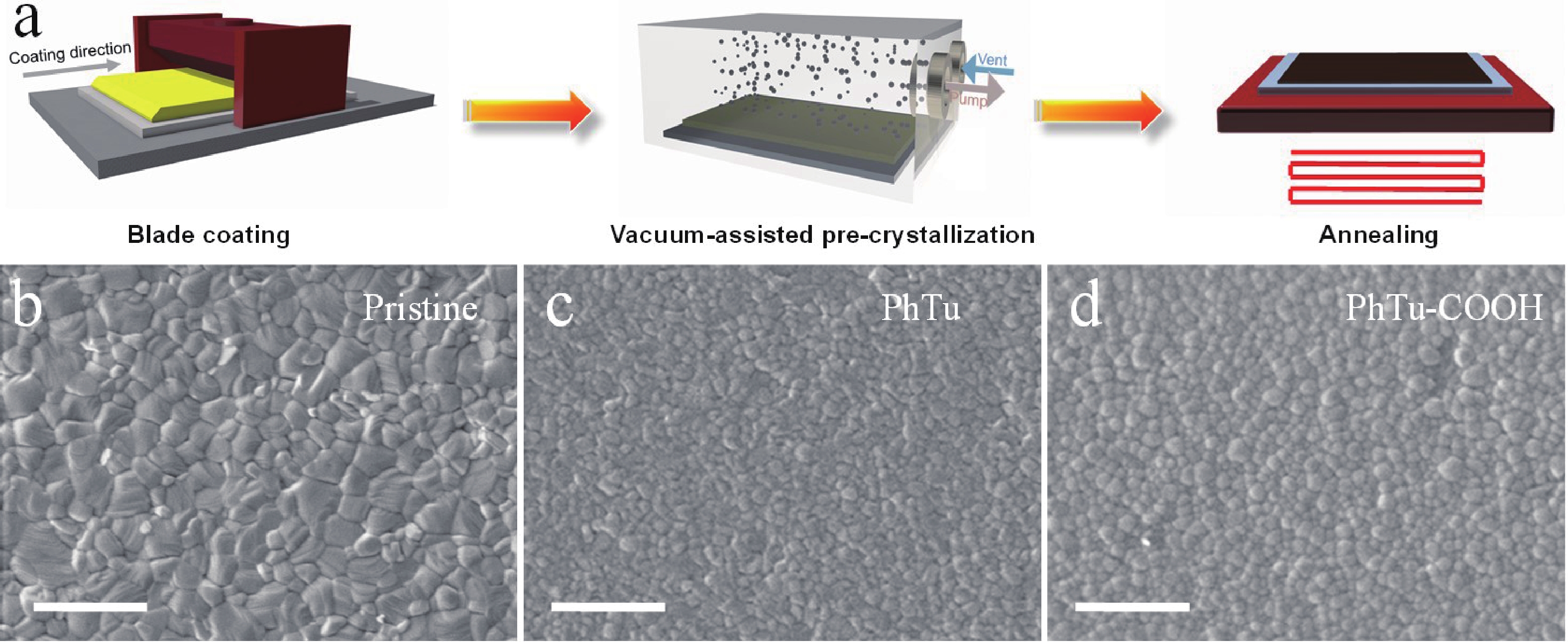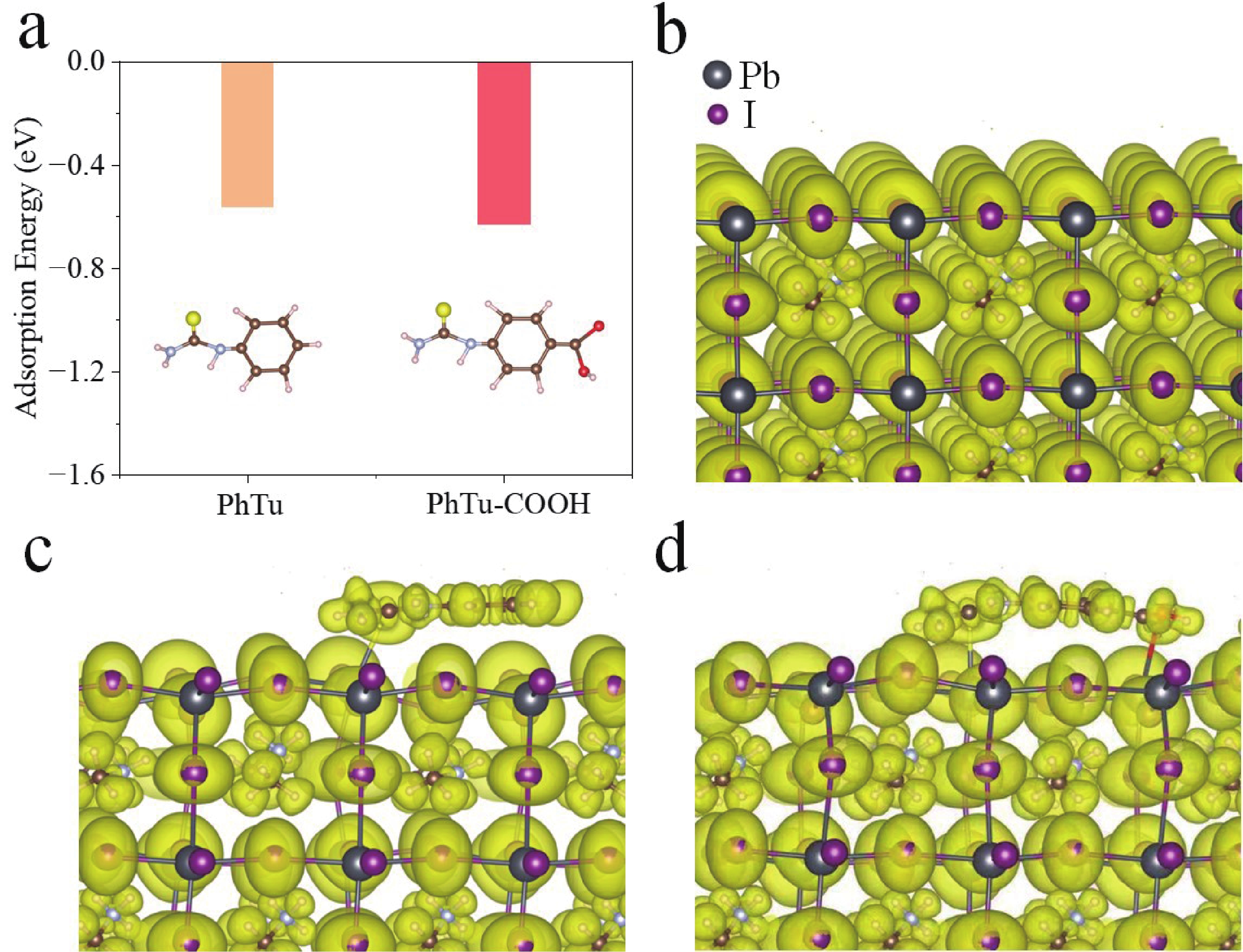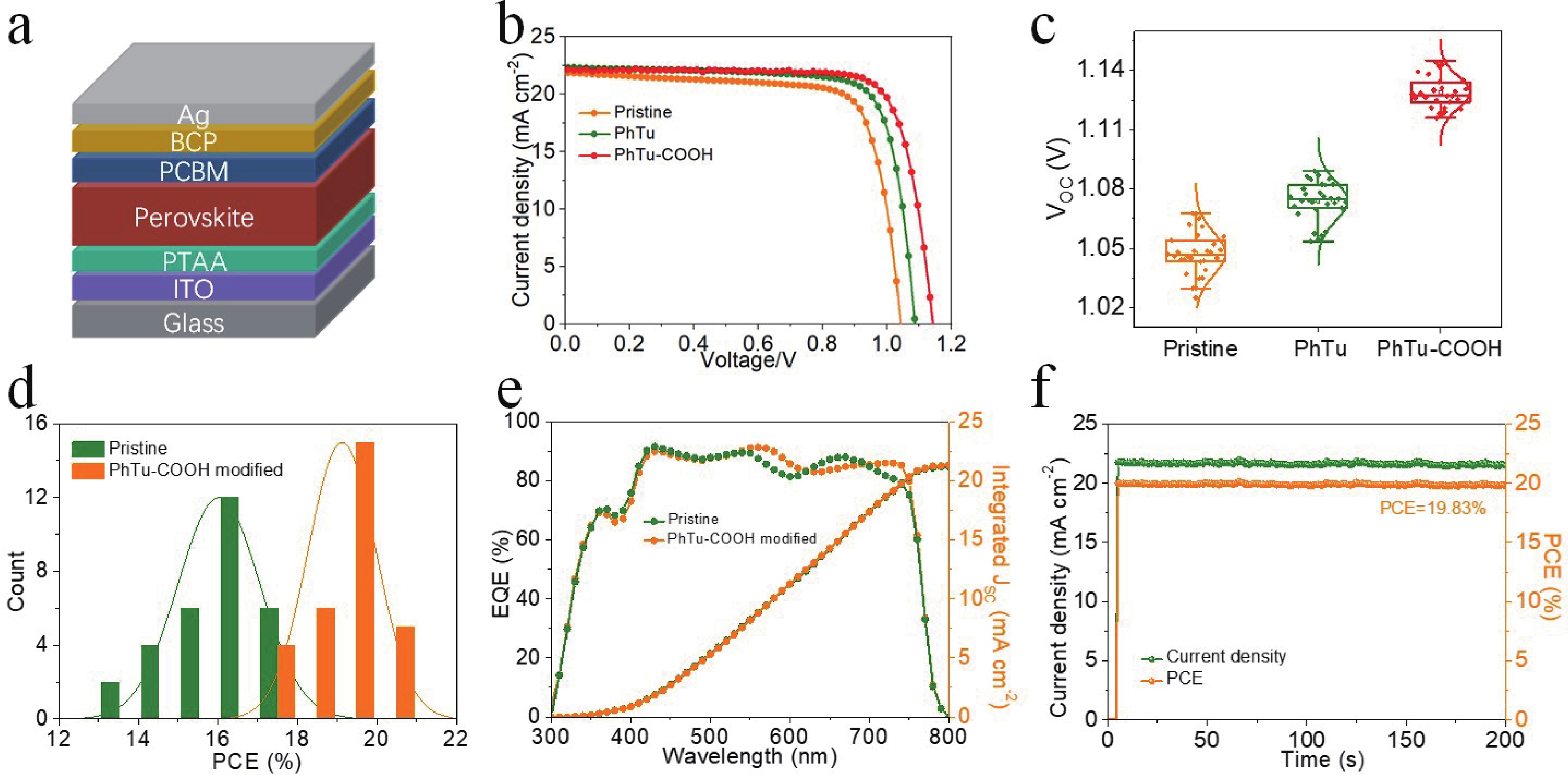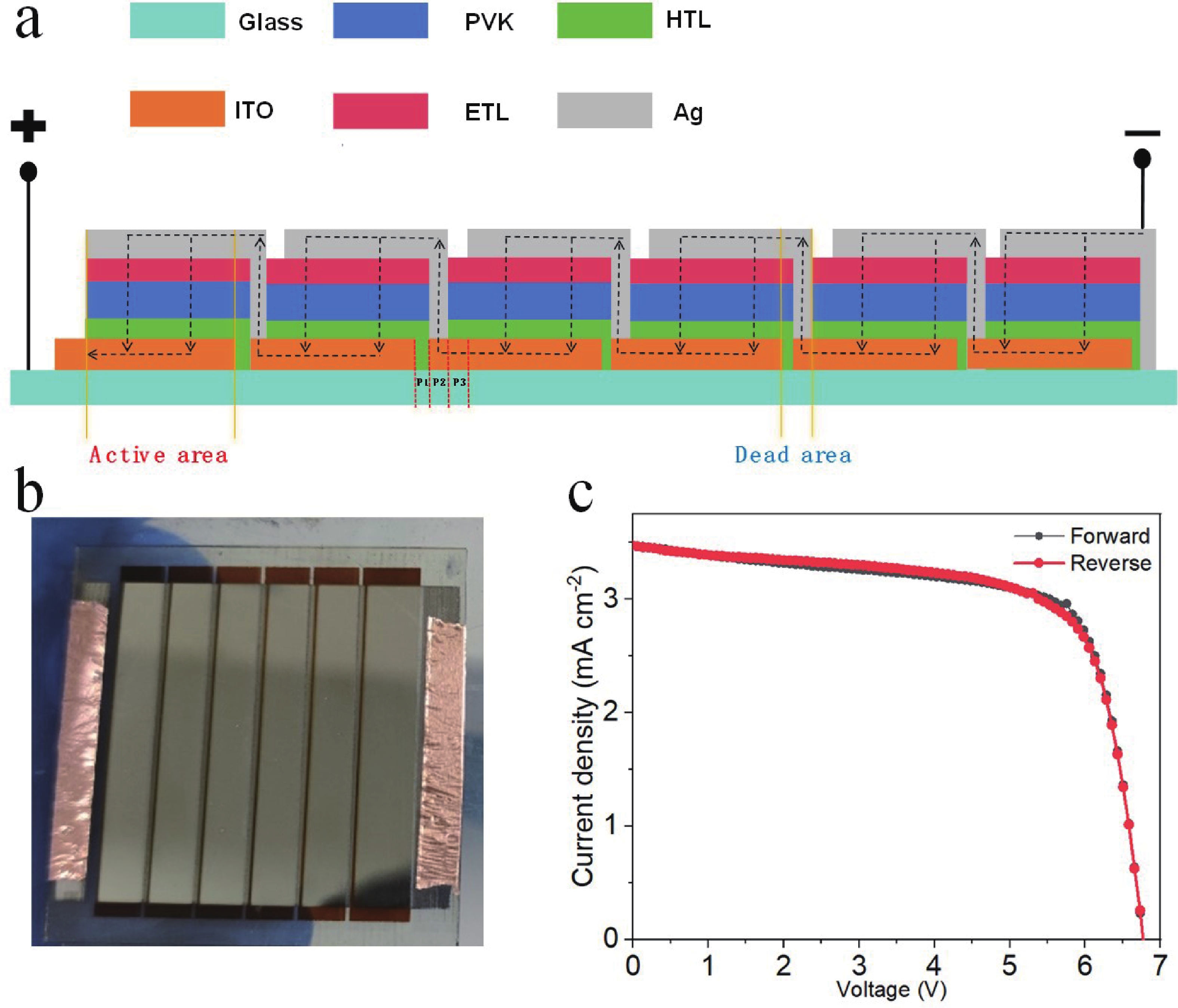| Citation: |
Jinlong Hu, Runxin Li, Qiongfeng Zhan, Jiajun Qin, Dadong Wen, Bing Yi, Huisheng Peng, Zhihang Tang. Overcoming photovoltage deficit via phenylthiourea derivatives for efficient printed perovskite solar cells with enhanced stability[J]. Journal of Semiconductors, 2026, In Press. doi: 10.1088/1674-4926/25080006
****
J L Hu, R X Li, Q F Zhan, J J Qin, D D Wen, B Yi, H S Peng, and Z H Tang, Overcoming photovoltage deficit via phenylthiourea derivatives for efficient printed perovskite solar cells with enhanced stability[J]. J. Semicond., 2026, 47(4), 042601 doi: 10.1088/1674-4926/25080006
|
Overcoming photovoltage deficit via phenylthiourea derivatives for efficient printed perovskite solar cells with enhanced stability
DOI: 10.1088/1674-4926/25080006
CSTR: 10.1088/1674-4926/25080006
More Information-
Abstract
Although the certified power conversion efficiency (PCE) of single-junction perovskite solar cells (PSCs) has achieved a high level of 27%, approaching the single-crystalline silicon solar cells, the device stability remains an urgent issue to be resolved for the commercialization. Defect passivation emerged as a viable approach to enhance the operational stability of the solar devices. Herein, phenylthiourea (PhTu) derivatives are selected as effective passivation agents to enhance the optoelectronic properties of printed methylammonium lead iodide (MAPbI3) films. It is demonstrated that incorporating a small amount of 1-(4-carboxyphenyl)-2-thiourea (PhTu-COOH) significantly reduces the trap-state density and leads to longer carrier lifetime of the perovskite films. As a result, the inverted solar device made of PhTu-COOH-modified MAPbI3 perovskite film shows remarkably improved efficiency (from 17.29% to 20.22%) and obviously increased open-circuit voltage (VOC) (from 1.043 to 1.143 V), as compared with the pristine device. Moreover, the PhTu-COOH-modified PSCs exhibit enhanced operational stability due to the significantly reduced trap-state density. Finally, the optimized solar module fabricated with an active area of 11.28 cm2 delivers a high PCE of 17.07% with negligible VOC loss, demonstrating the feasibility of the blade-coating method for large-area perovskite film deposition. -
References
[1] Zhu L F, Xu Y Z, Zhang P P, et al. Investigation on the role of Lewis bases in the ripening process of perovskite films for highly efficient perovskite solar cells. J Mater Chem A, 2017, 5(39), 20874 doi: 10.1039/C7TA05378A[2] Wang S, Ma Z R, Liu B B, et al. High-performance perovskite solar cells with large grain-size obtained by using the Lewis acid-base adduct of thiourea. Sol RRL, 2018, 2(6), 1800034 doi: 10.1002/solr.201800034[3] Ma Y H, Zhang S H, Yi Y W, et al. Deep level defects passivated by small molecules for the enhanced efficiency and stability of inverted perovskite solar cells. J Mater Chem C, 2022, 10(15), 5922 doi: 10.1039/D2TC00283C[4] Li Z H, Cao J G, Yang X J, et al. Buried interface engineering for MAPbI3 perovskite solar cells by the novel carbon nitride synergistic strategy. ACS Appl Mater Interfaces, 2025, 17(15), 22860 doi: 10.1021/acsami.5c03011[5] Hu J L, Xie D M, Tang Z H, et al. Flattening of the cratered inorganic perovskite film via precursor engineering for CsPbI2Br solar cells with 16.86% efficiency. ACS Sustainable Chem Eng, 2024, 12(35), 13392 doi: 10.1021/acssuschemeng.4c06058[6] Green M A, Dunlop E D, Yoshita M, et al. Solar cell efficiency tables (Version 66). Prog Photovoltaics, 2025, 33, 795 doi: 10.1002/pip.3919[7] Guo F, Qiu S D, Hu J L, et al. A generalized crystallization protocol for scalable deposition of high-quality perovskite thin films for photovoltaic applications. Adv Sci, 2019, 6(17), 1901067 doi: 10.1002/advs.201901067[8] Hu, J L, Wang C, Qiu S D, et al. Spontaneously self-assembly of a 2D/3D heterostructure enhances the efficiency and stability in printed perovskite solar cells. Adv Energy Mater, 2020, 10(17), 2000173 doi: 10.1002/aenm.202000173[9] Chen C R, Hu J L, Xu Z H, et al. Natural methionine-passivated MAPbI3 perovskite films for efficient and stable solar devices. Adv Compos Hybrid Mater, 2021, 4(4), 1261 doi: 10.1007/s42114-021-00238-9[10] Cho S P, Lee H J, Kang Y J, et al. More effective perovskite surface passivation strategy via optimized functional groups enables efficient p-i-n perovskite solar cells. Appl Surf Sci, 2022, 602, 154248 doi: 10.1016/j.apsusc.2022.154248[11] Lee J W, Bae S H, Hsieh Y T, et al. A bifunctional Lewis base additive for microscopic homogeneity in perovskite solar cells. Chem, 2017, 3(2), 290 doi: 10.1016/j.chempr.2017.05.020[12] Gao F, Chen W J, Li Y, et al. Enhancing efficiency of MAPbI3 perovskite solar cells with carbon quantum dot implanted g-C3N4: Controllable crystallization and surface passivation. J Alloys Compd, 2025, 1017, 179119 doi: 10.1016/j.jallcom.2025.179119[13] Lavoipierre R, Planes E, Flandin L, et al. Photovoltaic efficiency optimization of electrodeposited MAPbI3 perovskite: impact of ammonium valeric acid iodide additive. Chem Mater, 2024, 36(21), 10680 doi: 10.1021/acs.chemmater.4c02217[14] Chen B, Rudd P N, Yang S, et al. Imperfections and their passivation in halide perovskite solar cells. Chem Soc Rev, 2019, 48(14), 3842 doi: 10.1039/C8CS00853A[15] Li M Y, Yue Z Y, Ye Z C, et al. Improving the efficiency and stability of MAPbI3 perovskite solar cells by dipeptide molecules. Small, 2024, 20(25), e2311400 doi: 10.1002/smll.202311400[16] Liu Z W, Su Z, Yu B, et al. Biomaterial improves the stability of perovskite solar cells by passivating defects and inhibiting ion migration. ACS Appl Mater Interfaces, 2024, 16(24), 31218 doi: 10.1021/acsami.4c06285[17] Meng Y P, Zhang C X, Gong S B, et al. MAPbI3 perovskite inverted solar cell with bottom interface defects passivation via 2-thiophenemethylammonium bromide. J Power Sources, 2025, 629, 236058 doi: 10.1016/j.jpowsour.2024.236058[18] Mkawi E M, Qaid S M H, Roqan I S, et al. Enhancement the performance of MAPbI3 perovskite solar cells via germanium sulfide doping. Opt Mater, 2024, 157, 116089 doi: 10.1016/j.optmat.2024.116089[19] Abbas M, Cai B Y, Hu, J L, et al. Improving the photovoltage of blade-coated MAPbI3 perovskite solar cells via surface and grain boundary passivation with π-conjugated phenyl boronic acids. ACS Appl Mater Interfaces, 2021, 13(39), 46566 doi: 10.1021/acsami.1c11335[20] Choi M J, Lee Y S, Cho I H, et al. Functional additives for high-performance inverted planar perovskite solar cells with exceeding 20% efficiency: selective complexation of organic cations in precursors. Nano Energy, 2020, 71, 104639 doi: 10.1016/j.nanoen.2020.104639[21] Cao C T, Tao Y L, Yang Q, et al. Bilayer interfacial engineering with PEAI/OAI for synergistic defect passivation in high-performance perovskite solar cells. J Semicond, 2025, 46(5), 052805 doi: 10.1088/1674-4926/25030046[22] Alharbi E A, Alyamani A Y, Kubicki D J, et al. Atomic-level passivation mechanism of ammonium salts enabling highly efficient perovskite solar cells. Nat Commun, 2019, 10(1), 3008 doi: 10.1038/s41467-019-10985-5[23] Hu J L, Xu X, Chen Y J, et al. Overcoming photovoltage deficit via natural amino acid passivation for efficient perovskite solar cells and modules. J Mater Chem A, 2021, 9(9), 5857 doi: 10.1039/D0TA12342K[24] Qiu S D, Xu X, Zeng L X, et al. Biopolymer passivation for high-performance perovskite solar cells by blade coating. J Energy Chem, 2021, 54, 45 doi: 10.1016/j.jechem.2020.05.040[25] Wang K, Zheng L Y, Zhu T, et al. High performance perovskites solar cells by hybrid perovskites co-crystallized with poly(ethylene oxide). Nano Energy, 2020, 67, 104229 doi: 10.1016/j.nanoen.2019.104229[26] Yang S, Dai J, Yu Z H, et al. Tailoring passivation molecular structures for extremely small open-circuit voltage loss in perovskite solar cells. J Am Chem Soc, 2019, 141(14), 5781 doi: 10.1021/jacs.8b13091[27] Hu J L, Jiang X, Lan D H, et al. Lead carbanion anchoring for surface passivation to boost efficiency of inverted perovskite solar cells to over 25%. Chem Eng J, 2024, 499, 156037 doi: 10.1016/j.cej.2024.156037[28] Sun M N, Zhang F, Liu H L, et al. Tuning the crystal growth of perovskite thin-films by adding the 2-pyridylthiourea additive for highly efficient and stable solar cells prepared in ambient air. J Mater Chem A, 2017, 5(26), 13448 doi: 10.1039/C7TA00894E[29] Li Y, Duan Y W, Feng J S, et al. 25.71 %-efficiency FACsPbI3 perovskite solar cells enabled by A thiourea-based isomer. Angew Chem Int Ed, 2024, 63(49), e202410378 doi: 10.1002/anie.202410378[30] Wang Z, Zeng L X, Zhang C L, et al. Rational interface design and morphology control for blade-coating efficient flexible perovskite solar cells with a record fill factor of 81%. Adv Funct Materials, 2020, 30(32), 2001240 doi: 10.1002/adfm.202001240[31] Li X, Sheng W P, Duan X P, et al. Defect passivation effect of chemical groups on perovskite solar cells. ACS Appl Mater Interfaces, 2022, 14(30), 34161 doi: 10.1021/acsami.1c08539[32] Chen H, Liu T, Zhou P, et al. Efficient bifacial passivation with crosslinked thioctic acid for high-performance methylammonium lead iodide perovskite solar cells. Adv Mater, 2020, 32(6), e1905661 doi: 10.1002/adma.201905661[33] Liu X X, Cheng Y H, Liu C, et al. 20.7% highly reproducible inverted planar perovskite solar cells with enhanced fill factor and eliminated hysteresis. Energy Environ Sci, 2019, 12(5), 1622 doi: 10.1039/C9EE00872A[34] Liu Z Z, Cao F R, Wang M, et al. Observing defect passivation of the grain boundary with 2-aminoterephthalic acid for efficient and stable perovskite solar cells. Angew Chem Int Ed, 2020, 59(10), 4161 doi: 10.1002/anie.201915422[35] Li X, Chen C C, Cai M L, et al. Efficient passivation of hybrid perovskite solar cells using organic dyes with −COOH functional group. Adv Energy Mater, 2018, 8(20), 1800715 doi: 10.1002/aenm.201800715[36] Xie J S, Yan K Y, Zhu H Y, et al. Identifying the functional groups effect on passivating perovskite solar cells. Sci Bull, 2020, 65(20), 1726 doi: 10.1016/j.scib.2020.05.031 -
Supplements
 Supporting_information.pdf
Supporting_information.pdf

-
Proportional views





 Jinlong Hu received his Ph. D. degree from College of Chemistry and Chemical Engineering, Hunan University in 2018. He then joined the Institute of New Energy Technology at Jinan University as a postdoctoral fellow. He joined Hunan Institute of Engineering as a lecturer in 2021. His research focuses on perovskite solar cells.
Jinlong Hu received his Ph. D. degree from College of Chemistry and Chemical Engineering, Hunan University in 2018. He then joined the Institute of New Energy Technology at Jinan University as a postdoctoral fellow. He joined Hunan Institute of Engineering as a lecturer in 2021. His research focuses on perovskite solar cells. Zhihang Tang received his doctoral degree from Donghua University, Shanghai, China, in 2009. He is currently a Professor at the School of Information Science and Engineering, Hunan Institute of Engineering, Xiangtan, China. His current research interests include artificial intelligence, machine learning, and intelligent detection.
Zhihang Tang received his doctoral degree from Donghua University, Shanghai, China, in 2009. He is currently a Professor at the School of Information Science and Engineering, Hunan Institute of Engineering, Xiangtan, China. His current research interests include artificial intelligence, machine learning, and intelligent detection.
 DownLoad:
DownLoad:






















